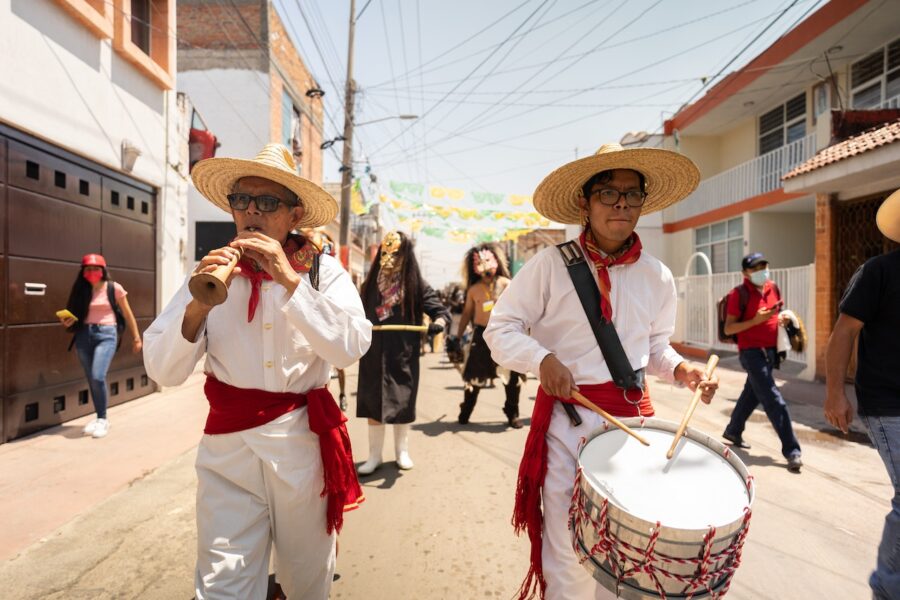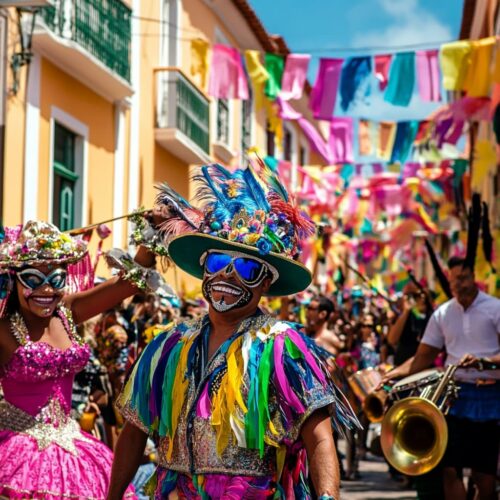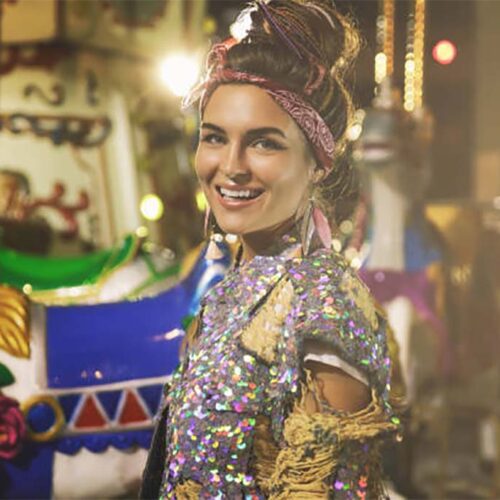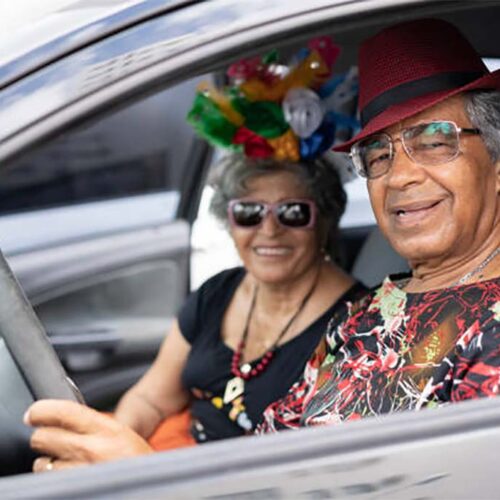From February 24 to 28, the carnival took place in sunny Rio de Janeiro, attracting thousands of tourists each year with its identity. Undoubtedly, the carnival in Rio is the most famous of all existing carnivals, but the truth is that many other, no less colorful celebrations take place in February in all corners of the world.
The tradition of carnivals dates back to the fourth and fifth centuries in Europe. The first festivals appeared in Italy, where the word “carnival” (from Italian carne, “meat”, and carrus, “machine”) was born, and later in France and Germany. Typically, celebrations take place in February or early March before Lent. A typical carnival is a lavish, circus-like parade, street parties, colorful masks and costumes that take one’s breath away, and where the leading motif is the exuberance that precedes Lent. Carnivals have always been popular mainly in Catholic countries.
The Venice Carnival is probably the most famous of all the carnivals held in Europe. It was first held in 1296, and its purpose was unbridled merriment, and the Italian masks became a symbol of disregard for social status, gender and religion. Nowadays, the Venice Carnival is one of the largest in the world, its atmosphere, history and unique masks are unique.
Another popular European carnival takes place in Portugal on the island of Madeira. The Portuguese always have two parades: one official, which requires careful preparation and always falls on a Saturday, and the second, the fun parade “Trapalhao”, in which everyone can participate. The traditional carnival dish is malasadas, a Portuguese dessert that resembles the usual doughnuts. Malasadas are made to get rid of the dough and sugar in the house before Lent.
Still, almost everyone associates the word “carnival” with Rio de Janeiro. And that’s no accident. In 2004, it was listed in the Guinness Book of World Records as the largest in the world, and in 2017, it brought in $740 million in revenue for Brazil. The first carnival was held in 1840. Then the waltz and polka took center stage in the entertainment program until 1917, when Africans discovered the rhythms and beauty of samba to Brazilians, thus fundamentally turning the history of the holiday upside down.
The first samba school opened in 1928 and immediately attracted a lot of followers. Today, the number of institutions that teach passionate dance and vocal performance can not be counted. Throughout the year, students and school leaders practice and rehearse hard to show their achievements to a strict jury and the audience at the main party of the world. They have 80 minutes to prove their excellence and win. The jury assesses not only the technique of performance, but also the costumes, which sometimes tell a whole story.
Carnival in Trinidad and Tobago is almost as famous as carnival in Rio. For this small nation, February is the most anticipated month of the year. Many point out the similarities between the carnivals in Trinidad and Tobago and Rio de Janeiro, but in fact each is different in its own way. Historically, music is very important to the festivities in Trinidad and Tobago. The unique calypso melodies, born in the late 20th century thanks to the slaves on the sugar plantations, are the first thing associated with carnival. Recently, another genre, soca, which, although descended from calypso, has its own individual sound, has also become increasingly popular. Various competitions, limbo, singing and “steel bands” are another integral part of the festivities.
Carnivals around the world are a hot topic in the news, for people who want to have fun, for vacations abroad, for video slot developers, casinos on the Net, and also for players.
The best winter carnivals in the world
February is the time of carnivals. During the last week before Lent, Catholics wanted to have one last laugh and had a boisterous feast with dressing up and fatty foods.
Carnival has long been the hallmark of Rio de Janeiro and Venice. Millions of tourists from all over the world go there to see the riot of colors and sounds with their own eyes. But no less interesting costume festivals with their own characteristics are held in dozens of places around the world.
In Russia, there is no large-scale costume holiday of its own yet: we are not used to having a noisy carnival on Shrovetide. RBC has selected seven of the most interesting carnivals from around the world.
Venice, Italy
Carnival in Venice is almost a thousand years old, the first documented mention of it dates back to 1094. The people of the Republic of Venice then celebrated loudly the tax privileges that gave them enormous advantages for Mediterranean trade.
Carnival was the golden age of the 18th century: for a week the virtuoso ladies and gentlemen were able to indulge in the pleasures of life with impunity, hiding their face under a mask. However, because of the revolutionary events of the end of the century the Italians had no time for masquerades. In the 1930s, Benito Mussolini banned carnival masks and festivities. The veto was lifted only in 1979 at the initiative of director Federico Fellini with the permission of the Pope.
Each year a new theme is invented for the masquerade. This time, the mood of the holiday is set by the slogan “Live in color. By the way, the Venice Carnival even has its own anthem, written by renowned fashion designer Pierre Cardin.
Traditionally, the carnival begins with the “Flight of Columbine”: a paper dove is launched from the bell tower of San Marco and the crowd of spectators is showered with a rain of confetti. After that, the main square turns into a theater stage. Gradually the performance moves to the narrow streets of the city, where the skills of musicians, dancers, jugglers and magicians demonstrate their skills. In the old palaces are balls, which you can get only if you have a costume. To appear at this time in Venice without a fine dress and fine masks is considered bad form. One of the most important events of the carnival is the competition for the best mask.
The tradition of carnival costumes dates back to the ancient Roman harvest festivals, the Saturnalia. During the festivities, slaves were allowed to sit at the same table with their lords, and so that class prejudice did not interfere with communication, they hid their faces under masks.
The carnival ends with the burning of a straw effigy, a rite that symbolizes the renewal of nature. The bells of the Church of San Francesco della Vigna ring to signal the beginning of Lent.
Rio de Janeiro, Brazil
A hot sight under the Brazilian sun is the carnival in Rio de Janeiro. The main attribute of the Brazilian carnival is the samba school parade. The movements of this dance came from the ritual African dances “semba,” and Portuguese folk songs were initially used as musical accompaniment. The first samba, written specifically for carnival, appeared in 1916 and was called “On the Telephone.
To the drumbeat, decorated platforms with dancers in shiny feather costumes float down the sambadrome. Today, samba schools are amateur associations that spend an entire year preparing for the carnival.
Each school chooses its own performance theme, according to which it sews costumes and makes scenery. One school can perform for up to an hour and a half, and half-naked dancers are accompanied by an entourage of several thousand people dressed in the colors of the school. Often famous artists and athletes are glimpsed in the carnival entourage.
This is not just a colorful spectacle, but also a competition. Brazilians cheer for their favorite school as passionately as they cheer for their soccer club – with cheers and applause. TV broadcasts from the sambodrome run for 10 hours a day throughout the carnival. Competitions take place in several leagues, with a championship performance by the winning school rounding out the festivities.
For the duration of the carnival, the mayor resigns, handing over the key to the city to the carnival king, Momo, who is elected from among the townspeople.
For a whole week, no one works in the country and car traffic stops on the streets. The festival fills all the beaches and streets: dancers and musicians, balls, parties and processions – you do not get bored these days.
By the way, many Rio residents flee the city for those days from the crowds of tourists and noise. However, carnival reigns throughout Brazil at this time, with samba school parades and concerts taking place in most cities.
Lucerne, Switzerland
In Lucerne, Switzerland, since the twelfth century, there has been an annual carnival of monsters, beasts and ghosts called Fastnacht. Legend has it that the carnival tradition began with the triumphant return of the local warriors after their victory over the Austrians in 1446.
The Fastnacht takes place six days before Lent, on Muddy Thursday. The festivities are started with a loud cannon shot, after which a man dressed as the legendary military commander emerges from the doors of the town hall. Street musicians, acrobats and dancers take part in the festivities. Scenes from Commedia dell’arte and impromptu concerts are staged in the squares, while the nighttime festivities spill over into bars and clubs.
Friday, Saturday and Sunday are not officially considered carnivals, but residents and tourists in Lucerne continue to have fun. On Monday, called Fat Monday, there is a big costume parade broadcast on Swiss television. Residents think carefully about their images and costumes. Here you can find orange cockroaches and astronauts, cartoon characters and Indians. And usually families or groups of friends dress in the same style.
The culmination of the holiday falls on Fat Tuesday: on this day there is a concert of monsters, and everything ends with a torch procession.
Remarkably, carnival days are not days off in Lucerne, and townspeople take vacations at their own expense. For these five days, offices, museums, and stores are closed in the city.
New Orleans, USA
Catholics call our Shrovetide counterpart Mardi Gras, which translates from French as “Fat Tuesday. One of the most colorful places to celebrate Mardi Gras is New Orleans. Residents of that French neighborhood celebrated the arrival of spring with a costume show, which over the years has grown into a full-fledged carnival.
In more than a century of celebrations, Mardi Gras has been canceled only about a dozen times: because of the yellow fever epidemic, the American Civil War and the World Wars. For a long time, blacks and whites in New Orleans had two independent carnivals. Incidentally, one of the first kings of the “black” carnival was the great Louis Armstrong. It wasn’t until the 1960s that Afro-Orleans took to the main streets of the city-before they had to confine themselves to the backstreets of their neighborhoods. Now it is a single carnival, combining several different parades. The most interesting are the Bacchus Parade, where each platform is dedicated to some pleasant vice, and the Indian Parade. There are also numerous balls, contests, and processions during Mardi Gras. Since New Orleans is the cradle of jazz, it is this music that sets the mood for the celebration.
The main characters at Mardi Gras are the carnival king and queen, who lead the procession. It’s considered that they began to be chosen in 1872, when fate brought the royal person to New Orleans on the eve of the holiday: the brother of the last Russian Tsar, Grand Duke Alexei Romanov, came there after his beloved. The organizers of the holiday were not confused and presented him with a funny crown.
A motley procession in masquerade costumes moved through the streets, and symbolic gifts such as beads, toys and carnival coins – doubloons – flew from the platforms into the crowd. To earn the beads, the girls bare their breasts. This custom, and the lifting of the ban on drinking alcohol on the streets during Mardi Gras, is why Americans call New Orleans the crazy city.
Mardi Gras lasts all day long, but at midnight sharp the carnival must end or else the souls of the revelers go straight to the clutches of the devil.
On this day, you must try the cake of the three kings, which looks like a multicolored pretzel with cinnamon. Inside it is baked a small figurine of a child symbolizing Jesus. Whoever gets this piece will have good luck all year long, and during the next Mardi Gras he must treat his friends to lunch.
Santa Cruz de Tenerife
The largest carnival in Europe takes place in the Canary Islands. For its scope in 1987, he even got in the Guinness Book of Records: 250 thousand people at the same time dancing salsa in the street.
Carnival on the island “brought” the Spaniards. They later began to persecute the street celebrations – during the Franco regime, even the word “carnival” was banned. However, the inhabitants of the island’s capital, Santa Cruz de Tenerife, ignored the ban and against all odds arranged the holiday. Officially the carnival returned to Tenerife with democracy in the 60’s. To attract tourists there was a “Winter Festival”.
The festivities usually last for a month, but the main events take place during the week. Carnival is unthinkable without a queen, who is chosen at the beginning of the holiday. The candidates for this honorary role prepare for the competition throughout the year. The unimaginably beautiful costume becomes a prerequisite for participation, as the girls can sometimes barely move due to its complexity and quirkiness.
Only then does the carnival come into its own. The city is flooded with costume parades, a parade of vintage cars, the rhythms of the rumba and samba sounds from everywhere, and rides are set up on the waterfront. The highlight of the island’s masquerade is the Murgas competition – performers of satirical rhymes on topical issues, as well as the election of the “most-amazing” among men dressed up as women. The children have their own carnival with the election of a little queen and processions.
The festive week ends with the “funeral of the Sardine. A large papier-mâché fish is burned at the stake and the fish ashes are buried on the beach, to the inconsolable lamentations of the “widows” represented by the mustachioed men.
Cologne, Germany
Carnival fun is not alien to the pedantic restrained Germans. At the end of winter, Cologne hosts a carnival, which for its scope and duration is even called the Fifth Season.
Preparations for the carnival begin in advance: On November 11 at 11:11 a.m., “carnival meetings” begin all over the city. Representatives of carnival communities gather in pubs and compose the festival slogan and song to table songs, and discuss the candidates for the main characters – the prince, the peasant and the maiden. And the carnival maiden is traditionally played by a man.
But all the fun begins only after three months. On Holy Thursday at 11:11 a.m. women dressed as witches and devils get the key from the mayor and proclaim the matriarchy for 24 hours. On this day, they can make fun of men by painting their faces with lipstick, kissing strangers unexpectedly or cutting off their ties. If desired, the “victim” can be invited for a mug of beer, a negative response on this day is not allowed. Experienced Germans slyly and go out on the streets in paper ties. However, once an unknowingly large American official came to the carnival in a tie for a few thousand euros, for which he soon enough paid the price.
On Saturday there is a procession of spirits, which allows people in costumes of ghosts and other other otherworldly creatures to participate. Sunday is children’s carnival time, with school children putting on their own processions and masquerades while the adults gain strength before Pink Monday.
The first day of the week is the main parade with the trio of heroes at the helm. The residents of Cologne have a lot of fun. They dress up in original costumes and carry papier-mache figures of political figures through the streets. There’s Putin in a crown and bear suit, Angela Merkel in a bikini, and Barack Obama the Superman. Participants in the parade throw candy to spectators – it takes up to 150 tons of candy every year to make an edible rain. To watch the show, tourists take seats on the sidewalks hours in advance, and some enterprising Germans even rent out their windows as observation points.
From there, the fun slowly winds down. On the evening of Violet Tuesday, a straw effigy is burned, getting rid of sins accumulated during the year before Lent.
Throughout the festival there are concerts, mock parties and the local beer, “Kölsch”, pours like a river.
Cologne’s carnival comes to an end on Ash Wednesday. The priests draw crosses of ash on the foreheads of the parishioners, forcing them to think about eternity.
Argentina, Entre Ríos Province, Gualeguaychú City
The longest carnival takes place in the Argentine town with the difficult-to-pronounce name Gualeguaychu. The festivities begin almost at the height of summer just after New Year’s Eve and continue every Saturday until early March. Locals call this time of carnival and love.
Argentine Carnival in the city of Gualeguaychu, a colorful, unique celebration of the fun of the famous artistic schools under the names: Marí-Marí (Marí-Marí), Kamarr (Kamarr), Papelitos (Papelitos – paper or confetti) and many others, in colorful and colorful costumes by which you can recognize certain characters, performing in synchronized choreography with their themed parade carriages expressing the elegant style of the Argentine people.
Carnivals in Argentina began as early as the Spaniards in the 17th century. Today, traditional costume parades are held in February in many cities in Argentina, but it is a small town Gualeguaychu near the border with Uruguay, for almost 30 years, has been the carnival capital of the country.
On Saturday night, the whole of Gualeguaychu and thousands of tourists make their way to the sambadrome, which is a half-kilometer street with bleachers on both sides. The sambadrome of Gualeguaychu has a capacity of 40,000 people. The cost of tickets for the carnival in recalculation on Russian money is from 300 to 5000 rubles. Near the sambadrom you can buy feathers, masks and hats, as well as try on heavy carnival outfits.
The action starts at about 10-11 p.m. and lasts about five hours. During this time, the spectators are shown their art by more than a thousand artists from various compars – carnival theater and dance groups of amateur artists. Each compares has its own style and costumes.
The first to hit the sambodrome track are the girls in feathers advertising the event’s sponsors. They warm up the audience by throwing souvenirs on the bleachers. Then, to the sound of fiery samba, a huge platform appears, surrounded by dancers.
Following the gnome, fairy castles, dragons, giants and even a cabaret platform accompanied by beautiful women dressed in feathers alternated before the eyes of the enthusiastic and fiercely cheering tributes to the different samba schools.
The carnival in little Gualeguaychu has a homely atmosphere, with parade participants forgetting their roles, running up to the stands to hug their relatives and neighbors, fans dancing, shouting, throwing confetti at the police and each other, and trying to take pictures with half-naked dancers.
The festivities wrap up at about 4 a.m. The townspeople scatter to their homes with shouts and songs, and the tourists who came especially for the carnival rush to the night bus, which takes them to Buenos Aires in 3 hours.



